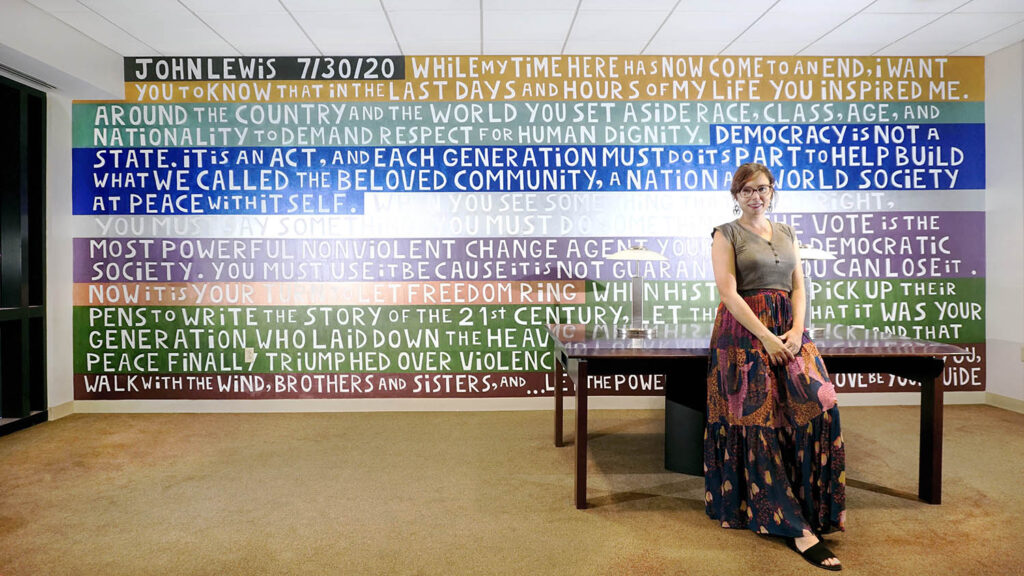Mural Installed in Piano Row as Inspiration, Call to Action

A 20-foot mural of words taken from the late Congressman and civil rights leader John Lewis’ final essay now covers a wall of the Quiet Lounge in Piano Row, a powerful rebuttal of hateful graffiti found on campus last spring.
The mural, “A Coney Island of the Mind,” by visiting artist Julia Csekö, features excerpts from Lewis’ essay, “Together, You Can Redeem the Soul of Our Nation,” published in The New York Times on July 30, 2020, the day the Congressman was laid to rest.
“The essay has many beautiful passages, and it was an incredible honor and pleasure to pick a few of his words to live within the Emerson campus,” Csekö said.
The mural was commissioned in response to anti-Semitic and white supremacist graffiti found on campus at the beginning of the Spring 2020 semester. In response, Emerson’s administration began a conversation with the student body to understand how they wanted to approach the incident.
Two Emerson students, Cassandra Shelley ‘22 and Jessica Ross ‘23, suggested to Dean of Campus Life Jim Hoppe that a mural be created.
“Much in the spirit of John Lewis’ lifelong advocacy for nonviolent protest, from a hateful act resulted a hopeful outcome,” Csekö said. “This mural was made to honor Lewis’ memory and entice the viewer to learn more about who he was and his exemplary life as an activist and statesman.”
Csekö, who previously had created a large-scale mural in the Walker Building that was destroyed during construction on the Dining Center, was invited for the commission at the recommendation of School of the Arts Dean Rob Sabal.
“Julia’s work combines text and image in the most powerful way, each one heightening the impact of the other,” Sabal said. “This mural seeks to inspire action — reminding us that the struggle to create a just and equitable world is a struggle that our community embraces.”
Leonie Bradbury, Foster Chair of Contemporary Art Theory and Practice, was asked to facilitate the creation of the mural, and as part of that process, spoke to a number of campus community members, including representatives from Academic Affairs, Campus Life, and several students, to gather input and advice. The Public Art Think Tank reviewed and vetted the proposal, and issued a letter of support to Sabal.
Conversations continued over the summer, and during the final, July 30 meeting with student representatives of the Student Government Association and Hillel to decide on the text selection, Bradbury suggested Lewis’ essay, just published that morning in the Times. (Other text under consideration included work by philosopher Hannah Arendt and poet Jessica Greenbaum.)
The students proposed that it was important for the message of the mural to be broadly inclusive, and that it address current social justice issues. They also felt it should offer a message of hope, love, and a call to action, Bradbury said. The Lewis text seemed to fit the bill.
“The text selection was of great importance,” Csekö said, “and everyone involved expressed the desire of an uplifting message, something that would propose and inspire, propel us to navigate the anxiety caused by the unstable political scenario and social distancing practices with strength and clarity.”
Lewis’ full essay will be displayed on an adjacent wall.
Join Csekö for a Virtual Artist Talk, Thursday, September 17, 6:30-8:00 pm. RSVP to leonie_bradbury@emerson.edu to receive the Zoom link.
This project is funded and supported by the Office of the Provost and Emerson Contemporary.
Categories